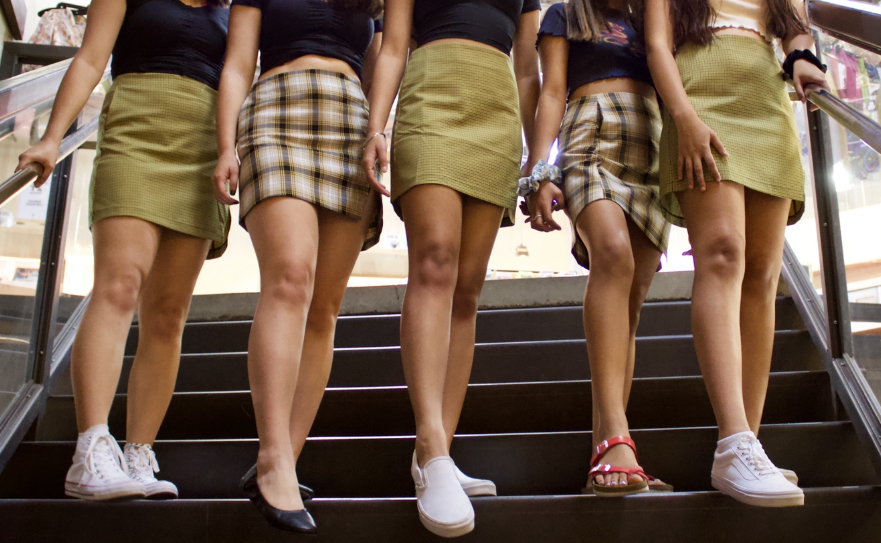Enforcement of dress code prompts questions among students
Walking down the steps of Urban Outfitters, Amanda Tolentino, Brianna Smith, Simran Atwal, Faith Ansaldo and Savannah Prasad reveal the different aspects of dress code broken. Pictured left, Tolentino meets school policy. Smith and Atwal, standing next to Tolentino, fail to satisfy the rules concerning midriff. However, their skirt length complies with guidelines. Students have protested dress code by purposely wearing clothing that fails to meet redundant dress code requirements. Photo by Paulina Solorzano

Editor’s note: This story was edited at 10:22 p.m. Sept. 3 to correct factual errors regarding the loaners provided for dress code violations. A previous version of the story misrepresented the policy based on information about the middle school policy at Granite Oaks. Whitney High Student Media is committed to accuracy and regrets the error.
With California’s 104-degree weather Aug. 15, students dressed for the scorching heat. However, students, particularly females, face consequences based on the dress code. If seen wearing a shirt that exposed the shoulders or the midriff, the discipline technicians would ask her to cover up or change into a Whitney T-shirt.
“During our intensely hot weather and in our generation, it is more commonly seen for feminine clothing to be shorter and less modest in the traditional sense,” Brianna Smith said.
In the midst of the recent dress code violations, tank top straps, crop tops and the length of shorts have students questioning whether the dress code discriminates by body type.
“Clothing doesn’t fit everyone the same way,” Capri Dace said.
Students share their perspectives on this seemingly annual issue: whether various heights, builds and genders are treated with equal guidelines.
With a mandatory discipline video shown to students Aug. 22, students reviewed the rules set in place concerning dress code in order to clarify the guidelines one was required to follow.
“We’re trying something a little different. Mr. [Jeff] Dietrich was working on dress code and there were about seven or eight staff members that wanted to have input on it. I’m hoping that since staff had a say in deciding what the dress code should be, then they will help enforce it. [Teachers] even helped with finding some of the pictures for what was appropriate. We consulted both with middle schools and Rocklin High School. The rules are pretty much the same,” Assistant Principal Mrs. Jennifer Hanks said.
The discipline video highlighted the consequences that would follow if students failed to satisfy these regulations. For example, students who break the dress code and are unable to provide an alternative outfit or cover-up are loaned school P.E. clothes.
“Intentional or not, [the loner clothing] seems to be used as a way to shame a student and make them very visible among their peers, thus making the fact that they were out of dress code widely known,” Smith said.
Though a number of students disagree with current dress code, administration has clarified the intentions behind the clothing provided. Loaner clothes are the only available option for those who do not have their own clothes on hand or cannot have clothes dropped off.
With clear instructions presented not only in the discipline video but on the school website and classroom doors, students are expected to follow protocol. Based on the changing fashion trends, the board and participating teachers gather to discuss improvements that are sufficient for both school guidelines and student comfort. “I think that [reforming the dress code] has to be a standing committee in order to be successful,” Mrs. Leah Seabrook said.
Nevertheless, students and admin alike believe reform is possible. “I think an effective dress code can serve the purpose of creating a more professional atmosphere on campus,” Sam Aggrey Fynn said.
The complaints of students who believe the dress code is unnecessarily strict has been heard by administration.“[Students] need encouragement more than strict rules. My shirt, [and] pants policy is just that,” Michael Whiteside said. Nonetheless, the administration has worked to satisfy both the board’s established guidelines and students’ requests.
“I think to change board policy would be extremely difficult. Board policy says no tank tops at all and we are allowing some. Dress code changes only because the styles change, ” Hanks said.
“The focus of policy [should take into account] … what the majority of students are comfortable with wearing and seeing on a daily basis,” Smith said.
As the current dress code is a revised version of the previous dress parameters, the guidelines are modified in response to the ever-changing fashion industry.
Seabrook said, “Students should definitely have a voice in how dress code is decided, but we also have to recognize the whims of the fashion industry. What your class decides now will not be the same as what five years from now students are wearing.”









